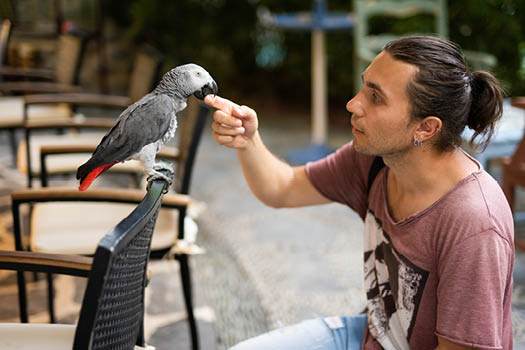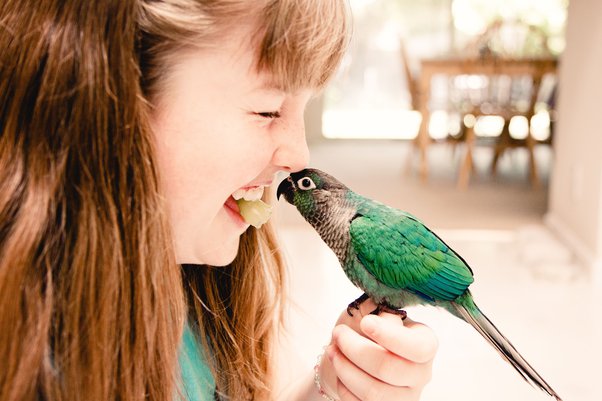
Parrots are intelligent, social creatures capable of forming deep bonds with their human companions. Making friends with a parrot requires patience, understanding, and consistent positive interactions. By following key steps, you can build trust and create a strong, lasting bond with your feathered friend. This article explores how to make friends with a parrot, ensuring a harmonious and rewarding relationship.
Understanding Your Parrot
Before attempting to make friends with your parrot, it’s crucial to understand their natural behavior and needs. Parrots are prey animals by nature, which means they can be cautious and wary of new experiences and people. They communicate through a combination of vocalizations, body language, and behaviors. Paying attention to these cues will help you understand your parrot’s feelings and intentions.
Every parrot is unique, with its own personality and preferences. Some parrots may be more outgoing and social, while others might be shy or reserved. Respecting your parrot’s individual personality is key to building trust.
Creating a Safe and Comfortable Environment
Creating a safe and comfortable environment is the foundation of building a relationship with your parrot. Ensure that your parrot’s cage is spacious and filled with stimulating toys, perches, and foraging opportunities. Place the cage in a part of your home where your parrot can observe daily activities but still feel secure.
Minimize loud noises and sudden movements around the bird cage, as these can startle and stress your parrot. Establishing a calm and predictable environment helps your parrot feel safe and more willing to engage with you.
Patience and Consistency
Building trust with a parrot takes time. Patience and consistency are crucial throughout this process. Begin by spending time near your parrot’s cage, talking to them in a calm and soothing voice. This helps your parrot become accustomed to your presence and associate you with positive experiences.
Avoid forcing interactions. Instead, allow your parrot to approach you when they feel comfortable. Consistent, daily interactions will gradually build trust and familiarity.
Using Positive Reinforcement
Positive reinforcement is a powerful tool for building trust and encouraging desired behaviors. Use treats, praise, and gentle affection to reward your parrot when they exhibit positive behaviors, such as approaching you, stepping onto your hand, or mimicking sounds.
Start with simple interactions, such as offering a treat through the bird cage bars. Gradually progress to more direct interactions, like having your parrot step onto your hand or finger. Each time your parrot responds positively, reward them immediately to reinforce the behavior.

Gentle Handling and Socialization
Once your parrot is comfortable with your presence and accepts treats from you, begin gentle handling and socialization. Start by offering your hand or finger as a perch inside the cage. Use a calm, steady approach, and avoid sudden movements that could startle your parrot.
If your parrot steps onto your hand, remain still and offer praise and a treat. Gradually increase the duration and frequency of these interactions. Over time, your parrot will learn to trust you and enjoy spending time with you outside the cage.
Socializing your parrot with other family members can also help build a well-rounded and confident bird. Encourage others to interact with your parrot using the same gentle and positive techniques.
Engaging in Interactive Play
Interactive play is an excellent way to bond with your parrot and provide mental stimulation. Use toys, games, and training sessions to engage your parrot and keep them entertained. Foraging toys, puzzles, and simple games like fetch can be both fun and enriching for your parrot.
Training sessions are particularly beneficial, as they provide structure and positive reinforcement. Teach your parrot basic commands and tricks, rewarding them with treats and praise for their efforts. Training not only strengthens your bond but also helps improve your parrot’s behavior and cognitive skills.
Understanding and Responding to Body Language
Reading and responding to your parrot’s body language is essential for building trust. Parrots use their feathers, posture, and vocalizations to communicate their feelings. For example, a relaxed parrot may fluff its feathers and make soft chirping sounds, while an anxious or scared parrot might flatten its feathers and make alarm calls.
Respect your parrot’s signals and adjust your interactions accordingly. If your parrot shows signs of stress or fear, give them space and time to calm down. Building a trusting relationship means acknowledging and responding to your parrot’s emotional state.
Conclusion
Making friends with a parrot involves patience, understanding, and consistent positive interactions. By creating a safe environment, using positive reinforcement, and engaging in gentle handling and interactive play, you can build a strong bond with your parrot. Understanding and respecting your parrot’s body language and individual personality are key to fostering trust and ensuring a harmonious relationship. With dedication and care, you can enjoy a rewarding and lasting friendship with your feathered companion.
How to Get a Parrot to Like You?
Building a bond with a parrot requires patience, consistency, and positive interactions. Start by spending quality time near the bird’s cage to let it get used to your presence. Talk to the parrot in a calm and soothing voice, offering treats and toys to create positive associations. Gradually increase interaction by offering your hand for the parrot to step onto, ensuring you move slowly and gently to avoid scaring it. Consistency in your approach will help the parrot feel safe and begin to trust you.
Can You Be Friends with a Parrot?
Absolutely, you can be friends with a parrot! Parrots are highly intelligent and social creatures that thrive on interaction. By dedicating time to bond with your parrot, engaging in activities it enjoys, and providing mental stimulation, you can develop a strong, trusting friendship. Remember that each parrot has a unique personality, so understanding and respecting its individual preferences and boundaries is key to fostering a positive relationship.
How Do I Make My Parrot Friendly?
To make your parrot friendly, start by creating a safe and comfortable environment for it. Spend time near the bird, talking softly and offering treats to build trust. Engage in interactive play with toys and teach simple tricks using positive reinforcement. Regular handling and gentle petting can help the parrot become more accustomed to human touch. Be patient and consistent, as building a friendly relationship with a parrot can take time.
How Do You Show a Parrot You Are Friendly?
Show your parrot you are friendly by approaching it calmly and speaking in a gentle tone. Offer treats and favorite foods from your hand to establish a positive connection. Avoid sudden movements or loud noises that could startle the bird. Spend time interacting with the parrot through play and gentle handling, allowing it to explore and become comfortable with you at its own pace. By consistently demonstrating kindness and patience, you will help your parrot recognize you as a friendly and trustworthy companion.
